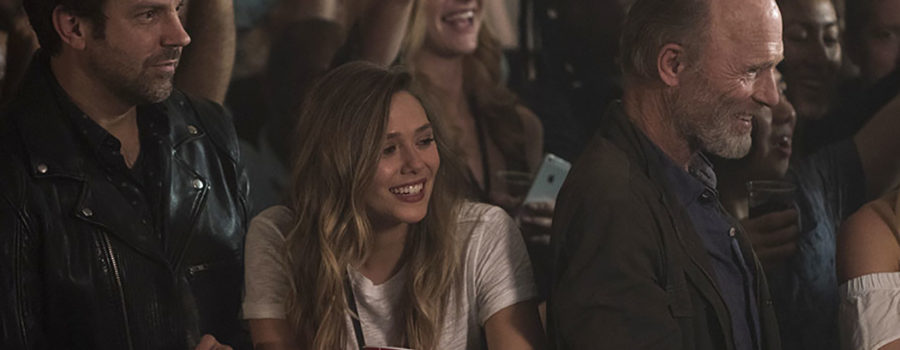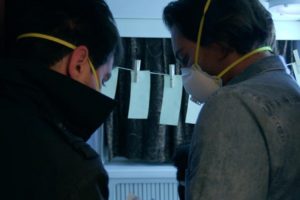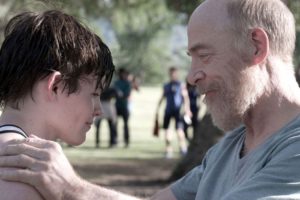[Published at Film Inquiry] Kodachrome had its United States premiere at the San Francisco International Film Festival on April 7, 2018. Star Jason Sudeikis, director Mark Raso, screenwriter Jonathan Tropper, and producer Eric Robinson were in attendance to represent the Netflix original for a Q&A moderated by Kodak CEO Jeff Clarke.
The credits rolled to a roaring ovation, and rightfully so; Raso‘s sophomoric feature film is a touching tribute to an era that once flourished, that of celluloid and analog technology. Kodachrome offers a trio of awe-inspiring central performances and a near-perfect combination of laughs and sniffles without throwing any cheap shots with excessive nostalgia; this is especially impressive given its title and premise.
An Anti-Nostalgic Father & Son Road Trip
Kodachrome follows Matt Ryder (Sudeikis in the performance of his career), a rock record label producer on the verge of being fired. His boss gives him an ultimatum, one last chance to sign a band that he likes. On that same day, a woman named Zoe (Elizabeth Olsen), informs Matt that his father, famed photographer Benjamin Ryder (played by Ed Harris in his finest performance since Pollock in 2000), is dying of liver cancer and that she is his caretaker. She explains that Ben’s dying wish is to get his last, undeveloped roles of Kodachrome developed before the photo lab closes permanently.
The only thing is, Matt hasn’t spoken to Ben, an absentee father in Matt’s youth, in ten years. Though, there’s a part of Matt that wants to see if his father has changed his ways. And so, Matt, Ben, and Zoe embark upon a journey to Kansas to develop the last roll of Kodachrome before the photo development system becomes obsolete, on the condition that they stop in Chicago so that Matt can meet with the band that his boss wants him to sign. What ensues isn’t exactly the classic father-son bonding trip that audiences are used to viewing.

source: Netflix
Kodachrome is based on a The New York Times article written by A.G. Sulzberger titled “For Kodachrome Fans, Road Ends at Photo Lab in Kansas” and published in 2010. One might say this is the first period piece based on a true story that takes place in the late 2010s. It was the end of a pivotal 20 to 30 years in technology, during which society saw a fundamental shift from analog to digital.
Along the road trip in Kodachrome, this is captured through Ben’s Kodak film that he shoots on to capture the journey, debates about shooting on film over digital, Ben’s 100% analog car that the three take to Kansas, cassette tapes and all, Matt’s GPS navigation system, Matt’s collection of old vinyl and his record player, Matt’s old drum set, the wonderful soundtrack, etc. Raso doesn’t shove these images in the viewer’s face, but rather, they serve as a subtle reminder of the crossroads of eras that was occurring at the time.
Manipulating Time, Quality Over Quantity, & The Loss Of Artifacts
There is a moment in Kodachrome when Ben proclaims that photographers take pictures to stop time; they capture a given moment forever because time moves too fast. When one has one month to live, this description of the vocation, hobby, or habit of photography serves as an apt reminder of how things could have gone in their life had they done certain things differently.
It used to be a lot longer of a process taking a photo, and the photo was printed onto an actual physical material, celluloid, instead of existing digitally via the cloud. Now, everyone who has a phone can take pictures. And so, the art form has been diminished and diluted a bit by digital technology. This is where the metaphorical generational battle comes into play.

source: Netflix
At one point, Matt says to Ben that he’d save everyone a lot of trouble if he’d just shoot on digital, to which Ben replies in his typical grumpy fashion, giving him his case for the preservation of film. Ben explains that, in the future, if everything is digital, there won’t be any physical remains of our artistry, history, our existence. After the screening of the film, Sudeikis, a photographer himself in real life who shoots on film, had this to say about shooting in film versus digital.
“It’s just the intention that you bring to the moment because – I mean, you know, weknow – you take photos of your family, your kids, your friends, your grandkids with your digital, and you’re just popping them off. And then you’re looking at them [*pretends to scroll on phone*] and then you get rid of some right there to leave room for the thing; you can’t do that with film. You can hear that whir if you’re right next to it and you’re doing a close up when you’re watching your fake father fake pass away. And yet, it provides almost this – almost like Catherine Keener‘s cup [laughs] – it’s the sound, you hear it, and it takes you to this place, and now I’m just here.
But it’s money. Everybody has to be on point. That whole opening where we’re going in through the steadicam shot and be going in through the concert – we did that later in the thing – that was just harmony amongst 16 people, like 25 people, one take, with film. It makes the bold gesture of actually doing of actually doing this communal thing of making something with the singular purpose of trying to make it great that much more special because you only get as much footage as you have to do it. You’re more on point.”
Father V. Son, Analog V. Digital
Ben is die hard everything-analog proponent. In fact, he hates digital. Matt is a product of the younger generation, and owns a cell phone and consumes content, among other things, digitally; instantly. This theme of analog versus digital in Kodachrome is representative of the differences that both separate Ben and Matt and the commonalities that make them similar. Ultimately, no matter how much they differ, Matt inherited his inclination for music and artistry, his passion for his work from his father.

source: Netflix
If one compares the two characters of Ben and Matt to their respective styles of technology, and, more specifically, photography, Ben, film, is made of grain, whereas Matt, digital, is made of pixels. Grain adds a character to a picture. If you take the exact same photo twice with film, the grains will move from picture to picture, whereas the pixels, if shot on digital, would remain exactly the same. Ben is sentimental about certain things about the past, but he doesn’t dwell on it.
Like Matt, the pixels are stuck. Matt dwells on the past – his wife’s divorce, his mother’s death, his dad’s abandoning of him – instead of being present or looking forward to the future. Digital is instant. Matt wants immediate results; he wants the trip with his father to end before it even begins. He’d rather use GPS navigation to find the fastest route. Film takes longer to develop. Ben would rather use an actual paper map and take the scenic route to reach the end result.
Conclusion: ‘Mama Don’t Take My Kodachrome Away’
Sings the great Paul Simon. Indeed, the audience won’t want Kodachrome to end. It truly is a remarkable film about the end of a generation. Fortunately, photographers such as Dan Winters and Petra Collins and filmmakers such as Christopher Nolan and James Gray still keep film alive in the digital age. “We’re not going away,” proclaimed Kodak CEO Clarke. In fact, Clarke announced plans to relaunch the Kodachrome product with higher EPA standards. So, perhaps viewers will be treated to a sequel.
Audiences won’t want to miss the superb soundtrack in Kodachrome which includes Indians, Live, Galaxie 500, RY X, Pearl Jam, and Graham Nash, as well as a fine score by Raso‘s Copenhagen collaborator, Agatha Kaspar. Appropriately and beautifully shot on 35mm celluloid by Raso, Kodachrome is a touching, hilarious, and contemplative gem of a film with three wildly meritorious performances by Harris, Sudeikis, and Olsen, and timely themes.
Do you prefer film or digital? Do you like the direction that Netflix is heading in? What is your favorite Sudeikis, Harris, or Olsen performance?
Kodachrome open on April 20, 2018 in the U.S. to a theatrical and Netflix release. For more information on its release, click here.
“The clock has run out on sexual assault, harassment and inequality in the workplace. It’s time to do something about it.” Read the Letter of Solidarity here. Make a donation to the legal fund here.





![‘The OA’: Creators Brit Marling & Zal Batmanglij Discuss The Long Journey Of Bringing ‘Part II’ To Life [Interview]](https://www.makingacinephile.com/wp-content/uploads/2019/03/The-OA-Part-II-Netflix-1200x520-300x200.jpg)


1 Comment
Leave your reply.